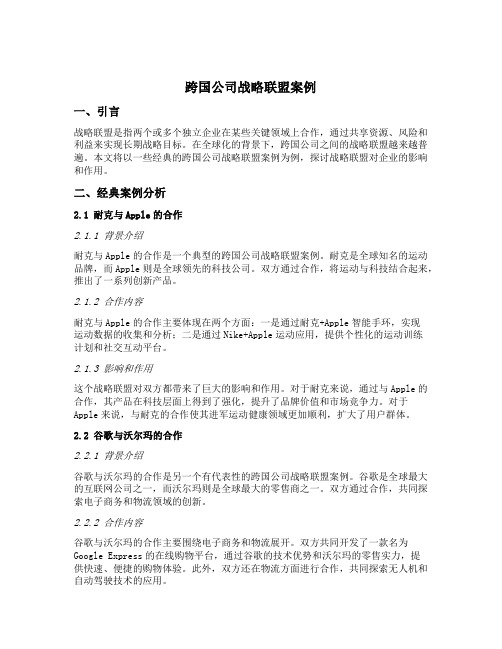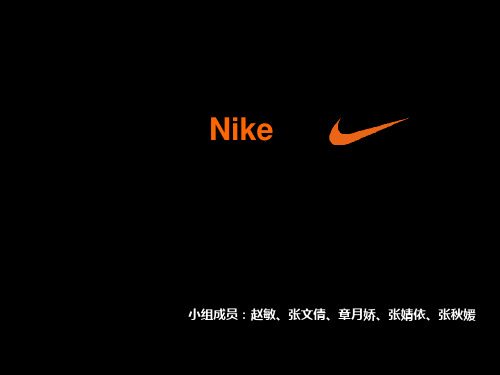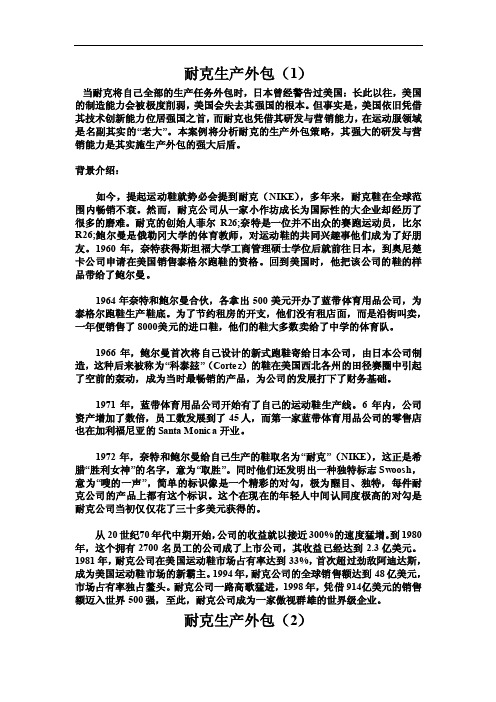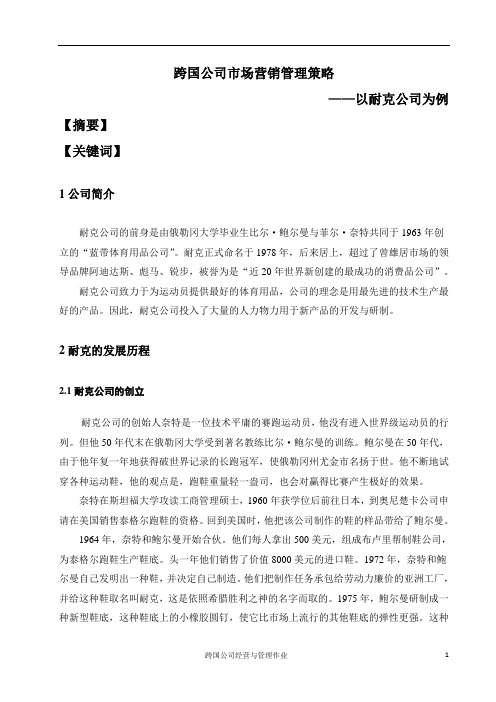耐克跨国投资案列分析
nike案例分析

Her risk free rate comes from 20-year T-bond rate Cohen uses average beta from 1996 to July 2001, 0.80. Cohen uses a geometric mean of market risk premium 5.9%
The WACC
Thus, my calculation of the WACC is as follow:
4.44%*0.101 + 9.81%*0.899 = 9.27%
What should Kimi Ford recommend regarding an investment in Nike?
Cost of debt
The WACC is used for discounting cash flows in the future, thus all components of cost must reflect firm’s concurrent or future abilities in raising capital. Cohen mistakenly uses the historical data in estimating the cost of debt. She divided the interest expenses by the average balance of debt to get 4.3% of before tax cost of debt. It may not reflect Nike’s current or future cost of debt.
Comments on cost of equity – The market risk premium
以耐克为例的跨国公司全球化生产及其影响

以耐克为例的跨国公司全球化生产及其影响一、什么是全球化生产所谓全球化生产,指的是某一产品价值链由不同国家的不同企业共同生产完成。
这时,生产的国家边界被突破,生产的企业边界也被突破,企业内部的生产经营行为延伸到其他企业。
在生产经营分工的基础上,企业之间的关系体现在各自从事同一产品价值链不同部分的生产。
有时候,产品的设计开发与营销均由同一家企业完成,但产品的设计开发、加工制造和营销必定不是由同一家企业完成,否则就不是全球化生产。
目前进行全球化生产的跨国公司相当多数是负责产品的设计开发与营销,而不进行加工制造。
二、全球化生产的四种基本方式全球化生产可以分成四种基本方式,即加工外包、原始设备制造、原始设计制造和原始品牌制造。
1、加工外包,即加工制造企业利用采购者提供的原材料从事加工生产,在我国被称作来料加工。
加工外包又分为两种形式:第一种是原料和成品不计价,加工制造企业收取约定的加工费。
另一种是原料和成品分别计价,加工制造企业通过对开信用证或付款交单的方式收取费用。
加工外包是全球化生产比较原始的方式。
2、原始设备制造(OEM),简称代工生产,是指加工制造企业按照采购者提供的设计方案生产并以采购者的品牌销售产品。
OEM可以分为两种类型:一种是购买者驱动型,即指由零售商和品牌企业来组织,零售商和品牌企业居于主导地位。
另一种是生产者驱动型,主要体现在机械设备、汽车、电子产品这些高技术产业。
因为其设计、开发较为复杂、技术水平较为特殊,生产企业、品牌企业和供应商在技术上和管理上的关系较为密切,所以他们由生产者来决定。
3、原始设计制造(ODM,原始设计制造商),简称设计外包,指的是委托企业(品牌企业)提出产品的大致要求后,受委托企业通过自己后期的研究开发,并最终生产出成品,该受委托企业被称作原始设计制造商。
OEM和ODM两者的相同点在于,它们都是贴牌生产,即加工制造出来的产品贴的是委托企业的品牌,不同点在于,原始设备制造商完全只是按单生产,而原始设计制造商则加入了自己的设计开发。
Nike, Cost of Capital 资本成本分析案例 PPT

该内在价值高于股票现价42.09美元,因此,股票价格被低估。可以进行投资。
案例问题
3
• Joanna计算的WACC有哪些错误? • 正确的计算方法是什么? • 计算正确的WACC • 计算每股的内在价值
什么是WACC
4
加权平均资本成本:英文Weighted Average Cost of Capital的缩写。WACC代表公司整体平均资金 成本,
Joanna的错误有哪些?
正确的WACC算法
7
其中,T取38%,则可计算得: RWACC=90%*7.661%+10%*7.167%*(1-38%)=7.333%
每股内在价值
8
每股的内在价值需要先计算出公司的内在价值,扣除负债得到股东权益价值, 再通过股东权益价值除去流通股数量。 本案例报告使用现金流量法来估算NIKE公司的内在价值。
1 Nike,inc:cost of cApital
案例背景
2
NorthPoint集团是美国一家基金公司,主要投资 于财富杂志评出的世界500强企业。Kimi Rord是 NorthPoint集团的一名证券投资部经理, 正在考 虑是否投资Nike公司的股份。Joanna Cohen, 作 为Kimi的助理,向Kimi提交了她的资本成本评估 报告。
Nike 1964年由Philip H. Knight在奥勒冈州 (Beaverton,Oregon.)创立,是一家美国体育用 品生产商,主要生产运动鞋、运动服装、体育 用品,以自己的品牌销售,分销商遍布全球。 Nike成立以来发展迅速,已成为全球体育用品的 代表性品牌。但1997年-2001年以来,公司经营 业绩较差,因此部分投资者持观望态度。
Nike Inc., Cost of Capital案例原文

Graduate School of Business Administration University Version 2.0 of VirginiaUVA-F-1353 Version 2.0Nike, Inc.: Cost of Capital On July 5, 2001, Kimi Ford, a portfolio manager at NorthPoint Group, a mutual fund management firm, pored over analyst write-ups of Nike, Inc., the athletic shoe manufacturer. Nike’s share price had declined significantly from the start of the year. Kimi was considering buying some shares for the fund she managed, the NorthPoint Large-Cap Fund, which invested mostly in Fortune 500 companies with an emphasis on value investing. Its top holdings included ExxonMobil, General Motors, McDonald’s, 3M and other large-cap, generally old-economy stocks. While the stock market declined over the last 18 months, NorthPoint Large-Cap had performed extremely well. In 2000, the fund earned a return of 20.7 percent even as the S&P 500 fell 10.1 percent. The fund’s year-to-date returns at the end of June, 2001 stood at 6.4 percent versus the S&P 500’s minus 7.3 percent. Only a week ago, on June 28, 2001, Nike held an analysts’ meeting to disclose its fiscal year 2001 results1. However, the meeting had another purpose: Nike management wanted to communicate a strategy for revitalizing the company. Since 1997, Nike’s revenues had plateaued at around $9 billion, while net income had fallen from almost $800 million to $580 million (see Exhibit 1). Nike’s market share in U.S. athletic shoes had fallen from 48 percent in 1997 to 42 percent in 2000.2 In addition, recent supply-chain issues and the adverse effect of a strong dollar had negatively affected revenue. At the meeting, management revealed plans to address both top-line growth and operating performance. To boost revenue, the company would develop more athletic shoe products in the mid-priced segment3 – a segment that it had overlooked in recent years. Nike also planned to push its apparel line, which, under the recent leadership of industry veteran Mindy Grossman4 had performed extremely well. On the cost side, Nike would exert more effort on expense control. Finally, company executives reiterated their long-term revenue growth targets of 8-10 percent, and earnings growth targets of above 15 percent.Nike’s fiscal year ended in May. Robson, Douglas, “Just Do…Something: Nike’s insularity and foot-dragging have it running in place”, Business Week, July 2, 2001 3 Sneakers in this segment sold for $70-$90 a pair. 4 Mindy Grossman joined Nike in September 2000. She was the former president and chief executive of Jones Apparel Group's Polo Jeans division.2 1This case was prepared from publicly available information by Jessica Chan under the supervision of Professor Robert F. Bruner. The financial support of the Batten Institute is gratefully acknowledged. This case was written as a basis for class discussion rather than to illustrate effective or ineffective handling of an administrative situation. Copyright 2001 by the University of Virginia Darden School Foundation, Charlottesville, VA. All rights reserved. To order copies, send an e-mail to dardencases@. No part of this publication may be reproduced, stored in a retrieval system, used in a spreadsheet, or transmitted in any form or by any means— electronic, mechanical, photocopying, recording, or otherwise—without the permission of the Darden School Foundation. Rev. 10/02.-2-UVA-F-1353Analyst reactions were mixed. Some thought the financial targets to be too aggressive; others saw significant growth opportunities in apparel and in Nike’s international businesses. Kimi Ford read all the analyst reports that she could find about the June 28 meeting, but the reports gave her no clear guidance: a Lehman Brothers report recommended a ‘Strong Buy’ while UBS Warburg and CSFB analysts expressed misgivings about the company and recommended a ‘Hold’. Kimi decided instead to develop her own discounted-cash-flow forecast to come to a clearer conclusion. Her forecast showed that at a discount rate of 12 percent, Nike was overvalued at its current share price of $42.09 (see Exhibit 2). However, she had done a quick sensitivity analysis that revealed Nike was undervalued at discount rates below 11.2 percent. Since she was about to go into a meeting, she requested her new assistant, Joanna Cohen, to estimate Nike’s cost of capital. Joanna immediately gathered all the data she thought she might need (Exhibits 1 through 4) and set out to work on her analysis. At the end of the day, she submitted her cost of capital estimate and a memo (Exhibit 5) explaining her assumptions to Ms. Ford.-3-UVA-F-1353Exhibit 1 Nike, Inc.: Cost of Capital Consolidated Income StatementsYear Ended May 31 (In millions except per share data) Revenues Cost of goods sold Gross profit Selling and administrative Operating income Interest expense Other expense, net Restructuring charge, net Income before income taxes Income taxes Net income Diluted earnings per common share Average shares outstanding (diluted) Growth (%) Revenue Operating income Net income Margins (%) Gross margin Operating margin Net margin Effective tax rate (%)* 1995 1996 1997 1998 1999 2000 20014,760.8 2,865.3 1,895.6 1,209.8 685.8 24.2 11.7 649.9 250.2 399.7 1.36 294.06,470.6 3,906.7 2,563.9 1,588.6 975.3 39.5 36.7 899.1 345.9 553.2 1.88 293.69,186.5 5,503.0 3,683.5 2,303.7 1,379.8 52.3 32.3 1,295.2 499.4 795.8 2.68 297.09,553.1 6,065.5 3,487.6 2,623.8 863.8 60.0 20.9 129.9 653.0 253.4 399.6 1.35 296.08,776.9 5,493.5 3,283.4 2,426.6 856.8 44.1 21.5 45.1 746.1 294.7 451.4 1.57 287.58,995.1 5,403.8 3,591.3 2,606.4 984.9 45.0 23.2 (2.5) 919.2 340.1 579.1 2.07 279.89,488.8 5,784.9 3,703.9 2,689.7 1,014.2 58.7 34.1 921.4 331.7 589.7 2.16 273.335.9 42.2 38.442.0 41.5 43.94.0 (37.4) (49.8)(8.1) (0.8) 13.02.5 15.0 28.35.5 3.0 1.839.6 15.1 8.5 38.540.1 15.0 8.7 38.636.5 9.0 4.2 38.837.4 9.8 5.1 39.539.9 10.9 6.4 37.039.0 10.7 6.2 36.0*The U.S. statutory tax rate was 35%. The state tax varied yearly from 2.5% to 3.5%. Source: Company's 10-K SEC filing, UBS Warburg-4Exhibit 2 Nike, Inc.: Cost of Capital Discounted Cash Flow Analysis2002 Assumptions: Revenue growth (%) COGS/Sales (%) S&A/Sales (%) Tax rate (%) Current assets/Sales (%) Current liabilities/Sales (%) Yearly depreciation and capex equal each other. Cost of capital (%) Terminal value growth rate (%) Discounted Cash Flow Operating income Taxes NOPAT Capex, net of depreciation Change in NWC Free cash flow Terminal value Total flows Present value of flows Enterprise value Less: current outstanding debt Equity value Current shares outstanding Equity value per share at 12% Sensitivity of equity value to discount rate: Discount rate 8.00% 8.50% 9.00% 9.50% 10.00% 10.50% 11.00% 11.17% 11.50% 12.00% 2003 2004 2005 2006 2007 2008 2009UVA-F-1353201020117.0 60.0 28.0 38.0 38.0 11.5 12.0 3.06.5 60.0 27.5 38.0 38.0 11.56.5 59.5 27.0 38.0 38.0 11.56.5 59.5 26.5 38.0 38.0 11.56.0 59.0 26.0 38.0 38.0 11.56.0 59.0 25.5 38.0 38.0 11.56.0 58.5 25.0 38.0 38.0 11.56.0 58.5 25.0 38.0 38.0 11.56.0 58.0 25.0 38.0 38.0 11.56.0 58.0 25.0 38.0 38.0 11.51,218.4 463.0 755.4 8.8 764.1 764.1 682.3 11,415.7 1,296.6 10,119.1 271.5 $ 37.271,351.6 513.6 838.0 (174.9) 663.1 663.1 528.61,554.6 590.8 963.9 (186.3) 777.6 777.6 553.51,717.0 652.5 1,064.5 (198.4) 866.2 866.2 550.51,950.0 741.0 1,209.0 (195.0) 1,014.0 1,014.0 575.42,135.9 811.7 1,324.3 (206.7) 1,117.6 1,117.6 566.22,410.2 915.9 1,494.3 (219.1) 1,275.2 1,275.2 576.82,554.8 970.8 1,584.0 (232.3) 1,351.7 1,351.7 545.92,790.1 1,060.2 1,729.9 (246.2) 1,483.7 1,483.7 535.02,957.5 1,123.9 1,833.7 (261.0) 1,572.7 17,998.7 19,571.5 6,301.5Current share price:$42.09Note: Terminal value is estimated using the constant growth model: Equity value $ 75.80 67.85 61.25 55.68 50.92 46.81 43.22 42.09 40.07 37.27 TV = FCF10 * (1 + Terminal value growth rate) WACC - g TV = $1,572.7 * (1.03) 12% - 3%-5Exhibit 3 Nike, Inc.: Cost of Capital Consolidated Balance SheetsMay 31, As of (In millions) Assets Current Assets: Cash and equivalents Accounts receivable Inventories Deferred income taxes Prepaid expenses Total current assets Property, plant and equipment, net Identifiable intangible assets and goodwill, net Deferred income taxes and other assets Total assets Liabilities and shareholders' equity Current Liabilities: Current portion of long-term debt Notes payable Accounts payable Accrued liabilities Income taxes payable Total current liabilities Long-term debt Deferred income taxes and other liabilities Redeemable preferred stock Shareholders' equity: Common stock, par Capital in excess of stated value Unearned stock compensation Accumulated other comprehensive income Retained earnings Total shareholders' equity Total liabilities and shareholders' equity 2000 2001UVA-F-1353$254.3 1,569.4 1,446.0 111.5 215.2 3,596.4$304.0 1,621.4 1,424.1 113.3 162.5 3,625.31,583.4 410.9 266.2 $ 5,856.91,618.8 397.3 178.2 $ 5,819.6$50.1 924.2 543.8 621.9 2,140.0 470.3 110.3 0.3$5.4 855.3 432.0 472.1 21.9 1,786.7 435.9 102.2 0.32.8 369.0 (11.7) (111.1) 2,887.0 3,136.0 $ 5,856.92.8 459.4 (9.9) (152.1) 3,194.3 3,494.5 $ 5,819.6Source: Company 10-K SEC filing.-6-UVA-F-1353Exhibit 4 Nike, Inc.: Cost of Capital Capital Market and Financial Information On or Around July 5, 2001Current yields on U.S. Treasuries 3-month 6-month 1-year 5-year 10-year 20-year 3.59% 3.59% 3.59% 4.88% 5.39% 5.74%Nike Share Price Performance Relative to S&P500: January 2000 to July 5, 20011.3 1.2 1.1 1.0 0.9 0.8 0.7 0.6 0.5 0.4 Feb-00 Aug-00 May-00 Sep-00 Feb-01 May-01 Nov-00 Jan-00 Jun-00 Jan-01 Jun-01 Jul-00 Mar-00 Apr-00 Mar-01 Dec-00 Oct-00 Apr-01 Jul-01Historical Equity Risk Premiums (1926-1999) Geometric mean 5.90% Arithmetic mean 7.50% Current Yield on Publicly Traded Nike Debt* Coupon 6.75% paid semi-annually Issued 07/15/96 Maturity 07/15/21 Current Price $ 95.60 Nike Historic Betas 1996 1997 1998 1999 2000 YTD 06/30/00 AverageNikeS&P 5000.98 0.84 0.84 0.63 0.83 0.69 0.80Nike share price on July 5, 2001: Dividend History and Forecasts Paymt Dates 31-Mar 30-Jun 1997 0.10 0.10 1998 0.12 0.12 1999 0.12 0.12 2000 0.12 0.12 2001 0.12 0.12$42.0930-Sep 0.10 0.12 0.12 0.1231-Dec 0.10 0.12 0.12 0.12Total 0.40 0.48 0.48 0.48Consensus EPS estimates: FY 2002 FY 2003 $ 2.32 $ 2.67Value Line Forecast of Dividend Growth from '98-00 to '04-'06: 5.50%* Data have been modified for teaching purposes. Sources of data: Bloomberg Financial Services, Ibbotson Associates Yearbook 1999, Value Line Investment Survey, IBES-7Exhibit 5 Nike, Inc.: Cost of Capital Joanna’s Analysis TO: FROM: DATE: SUBJECT: Kimi Ford Joanna Cohen July 6, 2001 Nike’s Cost of CapitalUVA-F-1353Based on the following assumptions, my estimate of Nike’s cost of capital is 8.4 percent: I. Single or Multiple Costs of Capital? The first question I considered was whether to use single or multiple costs of capital given that Nike has multiple business segments. Aside from footwear, which makes up 62 percent of revenue, Nike also sells apparel (30 percent of revenue) that complement its footwear products. In addition, Nike sells sport balls, timepieces, eyewear, skates, bats, and other equipment designed for sports activities. Equipment products account for 3.6 percent of revenue. Finally, Nike also sells some non-Nike branded products such as Cole-Haan dress and casual footwear, and ice skates, skate blades, hockey sticks, hockey jerseys and other products under the Bauer trademark. Non-Nike brands account for 4.5 percent of revenue. I asked myself whether Nike’s business segments had different enough risks from each other to warrant different costs of capital. Were their profiles really different? I concluded that it was only the Cole-Haan line that was somewhat different; the rest were all sports-related businesses. However, since Cole-Haan makes up only a tiny fraction of revenues, I did not think it necessary to compute a separate cost of capital. As for the apparel and footwear lines, they are sold through the same marketing and distribution channels and are often marketed in "collections" of similar design. I believe they face the same risk factors, as such, I decided to compute only one cost of capital for the whole company. II. Methodology for Calculating the Cost of Capital: WACC Since Nike is funded with both debt and equity, I used the Weighted Average Cost of Capital (WACC) method. Based on the latest available balance sheet, debt as a proportion of total capital makes up 27.0 percent and equity accounts for 73.0 percent:-8Capital sources Book Values Debt Current portion of long-term debt $ 5.4 Notes payable 855.3 Long-term debt 435.9 $ 1,296.6 Equity III. Cost of Debt $3,494.5UVA-F-135327.0% of total capital 73.0% of total capitalMy estimate of Nike’s cost of debt is 4.3 percent. I arrived at this estimate by taking total interest expense for the year 2001 and dividing it by the company’s average debt balance.5 The rate is lower than Treasury yields but that is because Nike raised a portion of its funding needs through Japanese yen notes, which carry rates between 2.0 percent to 4.3 percent. After adjusting for tax, the cost of debt comes out to 2.7 percent. I used a tax rate of 38 percent, which I obtained by adding state taxes of 3 percent to the U.S. statutory tax rate. Historically, Nike’s state taxes have ranged from 2.5 percent to 3.5 percent. IV. Cost of Equity I estimated the cost of equity using the Capital Asset Pricing Model (CAPM). Other methods such as the Dividend Discount Model (DDM) and the Earnings Capitalization Ratio can be used to estimate the cost of equity. However, in my opinion, CAPM is the superior method. My estimate of Nike’s cost of equity is 10.5 percent. I used the current yield on 20-year Treasury bonds as my risk-free rate, and the compound average premium of the market over Treasury bonds (5.9 percent) as my risk premium. For beta I took the average of Nike’s beta from 1996 to the present. V. Putting it All Together Inputting all my assumptions into the WACC formula, my estimate of Nike’s cost of capital is 8.4 percent. WACC = Kd (1-t) * D/(D+E) + Ke * E/(D+E) = 2.7% * 27.0% + 10.5% * 73.0% = 8.4%5Debt balances as of May 31, 2000 and 2001 were $1,444.6 and $1,296.6 respectively.。
跨国公司战略联盟案例

跨国公司战略联盟案例一、引言战略联盟是指两个或多个独立企业在某些关键领域上合作,通过共享资源、风险和利益来实现长期战略目标。
在全球化的背景下,跨国公司之间的战略联盟越来越普遍。
本文将以一些经典的跨国公司战略联盟案例为例,探讨战略联盟对企业的影响和作用。
二、经典案例分析2.1 耐克与Apple的合作2.1.1 背景介绍耐克与Apple的合作是一个典型的跨国公司战略联盟案例。
耐克是全球知名的运动品牌,而Apple则是全球领先的科技公司。
双方通过合作,将运动与科技结合起来,推出了一系列创新产品。
2.1.2 合作内容耐克与Apple的合作主要体现在两个方面:一是通过耐克+Apple智能手环,实现运动数据的收集和分析;二是通过Nike+Apple运动应用,提供个性化的运动训练计划和社交互动平台。
2.1.3 影响和作用这个战略联盟对双方都带来了巨大的影响和作用。
对于耐克来说,通过与Apple的合作,其产品在科技层面上得到了强化,提升了品牌价值和市场竞争力。
对于Apple来说,与耐克的合作使其进军运动健康领域更加顺利,扩大了用户群体。
2.2 谷歌与沃尔玛的合作2.2.1 背景介绍谷歌与沃尔玛的合作是另一个有代表性的跨国公司战略联盟案例。
谷歌是全球最大的互联网公司之一,而沃尔玛则是全球最大的零售商之一。
双方通过合作,共同探索电子商务和物流领域的创新。
2.2.2 合作内容谷歌与沃尔玛的合作主要围绕电子商务和物流展开。
双方共同开发了一款名为Google Express的在线购物平台,通过谷歌的技术优势和沃尔玛的零售实力,提供快速、便捷的购物体验。
此外,双方还在物流方面进行合作,共同探索无人机和自动驾驶技术的应用。
2.2.3 影响和作用这个战略联盟对双方都带来了显著的影响和作用。
对于谷歌来说,与沃尔玛的合作拓展了其电子商务业务,提升了用户体验和市场份额。
对于沃尔玛来说,与谷歌的合作加速了其数字化转型,提升了供应链效率和竞争力。
NIKE公司-跨国公司案例分析

品牌介绍 品牌发展 品牌文化 品牌产品 品牌战略 耐克在中国
运动的语言,运动的声音。
21
品牌介绍 品牌发展 品牌文化 品牌产品 品牌战略 耐克在中国
带来梦想.意味着行动。
22
品牌介绍 品牌发展 品牌文化 品牌产品 品牌战略 耐克在中国
鞋类
第一双华夫外底运动鞋 1972
第一双气垫运动鞋1979
23
品牌介绍 品牌发展 品牌文化 品牌产品 品牌战略 耐克在中国
鞋类
24
品牌介绍 品牌发展 品牌文化 品牌产品 品牌战略 耐克在中国
服装
25
品牌介绍 品牌发展 品牌文化 品牌产品 品牌战略 耐克在中国
装备
26
品牌介绍 品牌发展 品牌文化 品牌产品 品牌战略 耐克在中国
为什么耐克能占这么多的市场份额
品牌产品
品牌战略
耐克在中国
10
品牌介绍 品牌发展 品牌文化 品牌产品 品牌战略
1976-1977研发阶段
1、创新中犯了趋势性的错误,不符合人体运动原理。
2、开始学习科学性创新。
耐克在中国
11
品牌介绍 品牌发展 品牌文化 品牌产品 品牌战略
NIKE国际公司 1978
耐克在中国
进入加拿大、澳大利亚、 欧洲和南美等海外市场。
NIKE的创始人
田径教练比尔.鲍尔曼 1948- 1973
品牌战略
耐克在中国
5
胜利女神NIKE
品牌介绍 品牌发展 品牌文化 品牌产品
鲍尔曼手工制作的运动鞋
1、更轻质更舒适的运动鞋 2、更好的运动表现
品牌战略
耐克在中国
6
品牌介绍 品牌发展 品牌文化
NIKE的创始人
耐克生产外包案例分析

耐克生产外包(1)当耐克将自己全部的生产任务外包时,日本曾经警告过美国:长此以往,美国的制造能力会被极度削弱,美国会失去其强国的根本。
但事实是,美国依旧凭借其技术创新能力位居强国之首,而耐克也凭借其研发与营销能力,在运动服领域是名副其实的“老大”。
本案例将分析耐克的生产外包策略,其强大的研发与营销能力是其实施生产外包的强大后盾。
背景介绍:如今,提起运动鞋就势必会提到耐克(NIKE),多年来,耐克鞋在全球范围内畅销不衰。
然而,耐克公司从一家小作坊成长为国际性的大企业却经历了很多的磨难。
耐克的创始人菲尔R26;奈特是一位并不出众的赛跑运动员,比尔R26;鲍尔曼是俄勒冈大学的体育教师,对运动鞋的共同兴趣事他们成为了好朋友。
1960年,奈特获得斯坦福大学工商管理硕士学位后就前往日本,到奥尼楚卡公司申请在美国销售泰格尔跑鞋的资格。
回到美国时,他把该公司的鞋的样品带给了鲍尔曼。
1964年奈特和鲍尔曼合伙,各拿出500美元开办了蓝带体育用品公司,为泰格尔跑鞋生产鞋底。
为了节约租房的开支,他们没有租店面,而是沿街叫卖,一年便销售了8000美元的进口鞋,他们的鞋大多数卖给了中学的体育队。
1966年,鲍尔曼首次将自己设计的新式跑鞋寄给日本公司,由日本公司制造,这种后来被称为“科泰玆”(Cortez)的鞋在美国西北各州的田径赛圈中引起了空前的轰动,成为当时最畅销的产品,为公司的发展打下了财务基础。
1971年,蓝带体育用品公司开始有了自己的运动鞋生产线。
6年内,公司资产增加了数倍,员工数发展到了45人,而第一家蓝带体育用品公司的零售店也在加利福尼亚的Sa nta Monica开业。
1972年,奈特和鲍尔曼给自己生产的鞋取名为“耐克”(NIKE),这正是希腊“胜利女神”的名字,意为“取胜”。
跨国公司市场营销管理策略耐克为例

跨国公司市场营销管理策略——以耐克公司为例【摘要】【关键词】1公司简介耐克公司的前身是由俄勒冈大学毕业生比尔·鲍尔曼与菲尔·奈特共同于1963年创立的“蓝带体育用品公司”。
耐克正式命名于1978年,后来居上,超过了曾雄居市场的领导品牌阿迪达斯、彪马、锐步,被誉为是“近20年世界新创建的最成功的消费品公司”。
耐克公司致力于为运动员提供最好的体育用品,公司的理念是用最先进的技术生产最好的产品。
因此,耐克公司投入了大量的人力物力用于新产品的开发与研制。
2耐克的发展历程2.1耐克公司的创立耐克公司的创始人奈特是一位技术平庸的赛跑运动员,他没有进入世界级运动员的行列。
但他50年代末在俄勒冈大学受到著名教练比尔·鲍尔曼的训练。
鲍尔曼在50年代,由于他年复一年地获得破世界记录的长跑冠军,使俄勒冈州尤金市名扬于世。
他不断地试穿各种运动鞋,他的观点是,跑鞋重量轻一盎司,也会对赢得比赛产生极好的效果。
奈特在斯坦福大学攻读工商管理硕士,1960年获学位后前往日本,到奥尼楚卡公司申请在美国销售泰格尔跑鞋的资格。
回到美国时,他把该公司制作的鞋的样品带给了鲍尔曼。
1964年,奈特和鲍尔曼开始合伙。
他们每人拿出500美元,组成布卢里帮制鞋公司,为泰格尔跑鞋生产鞋底。
头一年他们销售了价值8000美元的进口鞋。
1972年,奈特和鲍尔曼自己发明出一种鞋,并决定自己制造。
他们把制作任务承包给劳动力廉价的亚洲工厂,并给这种鞋取名叫耐克,这是依照希腊胜利之神的名字而取的。
1975年,鲍尔曼研制成一种新型鞋底,这种鞋底上的小橡胶圆钉,使它比市场上流行的其他鞋底的弹性更强。
这种产品革新成就了奈特和鲍尔曼的事业。
然而推动耐克公司在美国市场上跨入最前列的真正动力主要的还不是产品革新而是仿造。
耐克公司以阿迪达斯公司的制品为模型进行仿造,结果,仿造者战胜了发明者。
2.2耐克公司的发展实践证明,鲍尔曼发明的鞋底大受运动员欢迎。
- 1、下载文档前请自行甄别文档内容的完整性,平台不提供额外的编辑、内容补充、找答案等附加服务。
- 2、"仅部分预览"的文档,不可在线预览部分如存在完整性等问题,可反馈申请退款(可完整预览的文档不适用该条件!)。
- 3、如文档侵犯您的权益,请联系客服反馈,我们会尽快为您处理(人工客服工作时间:9:00-18:30)。
耐克公司当前的WT战略:
①紧缩战略:克服公司在产品质量方面的不足,通过更 加严格的生产管理,保证产品质量尽快提高;同时,要 规避全行业质量普遍提高使居民可选择余地增加的威胁, 在保持高端产品形象的同时,要注意控制成本,使公司 能够提供物美价廉的产品。
②横向一体化战略:要克服公司产品质量和产品舒适度 方面的不足,规避行业进入的低门槛、潜在进入者进入 壁垒较低的威胁、规避全行业质量普遍提高使居民可选 择余地增加的威胁和国产运动品牌崛起的威胁,积极研 发新产品,使顾客可选择余地增加,从而保证公司的市 场份额。
②市场发展战略:要利用中国经济的强劲增长和居民收入 普遍提高,消费能力 增强的市场机遇,发挥耐克公司在企 业形象和声誉、品牌价值和产品外形设计方面的优势。
③产品发展战略:要利用中国经济的强劲增长和居民收入 普遍提高,消费能力 增强的市场机遇,发挥耐克公司在产 品外形设计方面的优势,加大研发投入,使公司的研发优 势更加突出。
自然环境:东南亚国家用于制鞋的自然资 源丰富,人口基数大。
经济环境:第三世界国家经济普遍不发达 ,人口众多,有着巨大的市场潜力。
政治环境:第三世界国家政治基础薄弱, 存在市场风险。
法律环境:第三世界国家法律基础有待完 善,需要做风险评估。
耐克公司设在越南的制鞋厂
由于劳动力等成本的提高,耐克的制 造部分纷纷转战东南亚一些成本相对 较低的国家,从而保住自己的利润率。
1、创新科技 2、符合生理学、物理学,使用材料使运 动鞋更具功能性
1980-1981年,在美国的成长与发展扩张
1971年,因为名叫耐克的胜利女 神有一对舞动的翅膀,学生卡洛林。 戴维森设计了第一个Swoosh标志, 同时也是运动鞋的抽象表现。 1978年,耐克的Swoosh标志由框 线变为实形,出现在标准字的下方, 更加醒目突出。
对我国直接投资的启示
制定发展跨国公司的战略计划
推进企业兼并力度,促进企业强强联合 ,组建我国的大企业集团
政府应发挥建立和完善市场竞争规则的 作用,在宏观上为企业创造一个公平竞 争的环境。 培养擅长跨国经营的企业家
制定我国私营企业海外直接投资的方针 、政策和措施
SWOT分析
内部环境
优势
劣势
外
Strengths
97%以上的耐克运动鞋的生产采取在第三世界国家合同承 包、加工返销的形式进行,其中有相当一部分在中国、韩 国和印度尼西亚生产,由耐克公司收购,再销往世界各地。 一双印尼制造的耐克鞋生产成本为5.6美元,在北美和欧洲 市场可以平均卖到73美元甚至135美元。
销售毛利率(大约)
73 - 5.6 73
135 - 5.6 135
机会(O)
威胁(T)
1、人们健康、运动观念的影响 2、亚洲等人口较多的国家和地区收 入快速增长
1、国内和国际激烈的竞争 2、年轻消费者消费偏好改变 3、汇率的波动 4、全球金融危机的潜在影响 5、进出口规章的不利影响
耐克公运司用当前S的WSOO战T略做: 出战略分析
①市场渗透战略:要利用生活节奏加快、竞争加剧,社会 群体对休闲运动需求增加的市场机会,充分发挥耐克公司 在企业形象和声誉、品牌价值和产品外形设计方面的优势, 使公司的SO战略发挥的更好。
优惠政策导向:利用东道国政府的优惠 政策
全球战略导向:耐克企业以公司整体利
跨国投资的环境分析
国际直接投资环境是指影响国际投资活 动的各种自然、经济、政治、社会和法 律因素的综合体。
由于耐克公司国际投资主要集中在第三 世界国家,如:中国、韩国、印尼、泰 国。所以做环境分析时以第三世界国家 的环境为主要目标。
JUST DO
IT
企业简介
企业发展历 程
跨国投资分 析
SWOT分析
耐克企业简介 1963年,比尔· 鲍尔曼和菲尔· 奈特
创立为“蓝带体育用品公司”
1972年,蓝带公司更名为耐克公司, 从此开始缔造属于自己的传奇
Nike正式命名于1978年,年轻而又活 力,总部位于美国俄勒冈州。
Nike开始了草根推广(1972) 蓝带体育首次在1972年美国奥运越野赛 中推出了Nike 1976-1977年,研究,设计和发展的重要 时期
耐克公司通过在国外创立独资、合资或 合作公司,也通过增加对原有国外企业 的投资、收购或兼并东道国现存企业来 实现其ห้องสมุดไป่ตู้展与扩张。
耐克国际投资的动机
自然资源导向:原材料、橡胶
市场导向:1、规避贸易壁垒 2、保护 和扩大市场份额 3、开辟新市场 效率导向:利用境外廉价劳动力、土地 资源,降低生产经营成本,提高生产效 率
耐克跨国投资的方式
国际直接投资主要通过两种方式进行: 一是在国外创建新企业(绿地投资), 二是进行跨国并购。
创建新企业是指跨国公司等投资主体 在东道国境内依照东道国的法律设立的部 分或全部资产所有权归投资者所有的企业 。
跨国并购是指外国投资者通过一定的 法律程序和渠道,取得东道国某企业的全 部或部分所有权的投资行为。
1985年,标志组合在方形中,形成 正负效果。
如今,Swoosh标志依据需要被单 独运用。
耐克跨国投资分析
直接投资的概念 跨国投资的动机 跨国投资的环境分析 跨国投资的方式 对我国直接投资的启示
直接投资
概念:国际直接投资又称对外直接投资 (FDI),是指投资者为了取得长期投 资利益而在外国创立公司并控制其经营 管理权的投资行为。
部
环
境 机会
Weakness 威胁
Opportunities
Threats
耐克优公势(司S) 竞争战略SW劣势O(WT)分析
1、品牌认知度高 2、顾客忠诚度高 3、市场响应度高 4、良好的财务状况 5、强大的营销网络 6、强大的研发队伍与研发能力 7、树立了良好的公司形象
1、多样化经营战略起步较晚 2、女性产品、鞋子不多 3、同远东的低工资工厂靠合同进行 生产使公司易受到法律、自然灾害和 国外经济问题的影响
